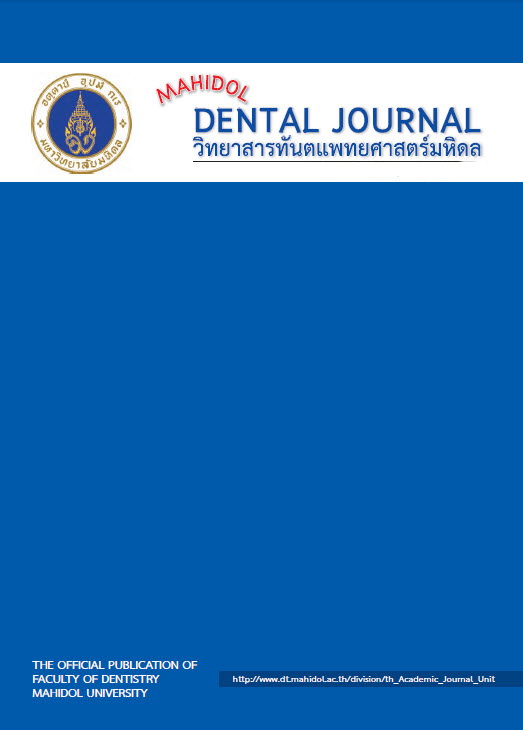Modification of curing technique of a ‘self-cure’ injection molding denture base materials: Effect on flexural strength
Main Article Content
Abstract
Objectives: This study compared the flexural strength of a self-cure injection-molding denture base material, which its curing process was modified from that recommended by the manufacturer, when stored in water at 7 days and 30 days.
Materials and methods: Twenty rectangular specimens (10mm x 64mm x 3.3mm) were prepared according to ISO 20795-1:2013 for each experiment group. SR Ivocap® High Impact were wet cured at 100 OC for 35 min (Ivocap wet curing). IvoBase® Hybrid were dry cured in an automated instrument which the curing temperature started from 40 OC up to 120 OC for 35 min (IvoBase dry curing). IvoBase® Hybrid were also wet cured at 100 OC for 35 min (IvoBase wet curing). Ten specimen in each group were immersed in 37oC distilled water for 7 days and the other 10 specimens at 30 days. At the end of the storage periods, three-point bending flexural strength test with a 5 mm/min crosshead speed was carried out using a universal testing machine. Nonparametric test (Kruskal Wallis and Mann-Whitney) was used to compare the flexural strength data.
Results: The median, 25th percentiles and 75th percentiles values of flexural strength of SR Ivocap® High Impact wet curing, IvoBase® Hybrid dry curing and IvoBase® Hybrid wet curing and were 61.5(61.2,63.1), 78.9(75.6,81.7) and 68.0(61.4,70.2) MPa, respectively for 7 days immersion; and, 62.6(59.2,63.6), 68.3(66.4,72.5) and 64.4(50.7,67.2) MPa, respectively for 30 days immersion. The flexural strength of Ivocap High Impact was significantly lower than that of IvoBase Hybrid (p<0.05). The flexural strength of IvoBase® Hybrid dry curing was significantly higher than that of IvoBase Hybrid wet curing. (p<0.05). The flexural strength of IvoBase Hybrid decreased when immersion in water up to 30 days.
Conclusion: Flexural strength of IvoBase® Hybrid was higher than that of SR Ivocap® High Impact but decreased for water storage up to 30 days. Alternative curing of IvoBase Hybrid did not improve its flexural strength.
Article Details
References
2. Mccabe JF. and Walls A.W.G. Applied dental materials:9th edition Blackwell publishing Ltd.2008.
3. International Standard. ISO 20795-1 for Dentistry. Dentistry — Base polymers —Part 1: Denture base polymers. Geneva, Switzerland: International organization for Standardization; 2013.
4. Anusavice K, Shen C, Rawls H. Phillip's Science of Dental Materials. 12th ed. Missouri: Elsevier Inc; 2013.
5. Jagger D.C, Harrison A. and Jandt K.D. Review The reinforcement of dentures. J Oral Rehabil 1999; 26: 185-94.
6. Beyli MS, von Fraunhofer JA. An analysis of causes of fracture of acrylic resin dentures. J Prosthet Dent 1981; 46: 238-41.
7. Kydd W.L. Complete base deformation with varied occlusal tooth form. J Prosthet Dent. 1956;6:714–18.
8. Rees J.S, Huggett R. and Harrison A. Finite element analysis of the stress concentrating effect of frenal notches in complete dentures. Int J Prosthodont 1990; 3: 238–40.
9. Yunus N., Harrison A and Huggett R. Effect of microwave irradiation on the flexural strength and residual monomer levels on an acrylic repair material. J Oral Rehab 1994; 21: 641–8.
10. El-Sheikh A.M. and Al-Zahrani S.B. Causes of denture fracture : A survey. Saudi Dental Journal 2006; 18: 149-54.
11. Ali IL, Yunus N and Abu-Hassan MI. Hardness, Flexural Strength, and Flexural Modulus Comparisons of Three Differently Cured Denture Base Systems.
J Prosthodont 2008; 17: 545-9.
12. Gharechahi J, Asadzadeh N, Shahabian F and Gharechahi M. Flexural Strength of Acrylic Resin Denture Bases Processed by Two Different Methods. J Dent Res Dent Clin Dent Prospect 2014; 8: 148-52.
13. Ganzarolli SM, de Mello JA, Shinkai RS, Del Bel Cury AA. Internal adaptation and some physical properties of metha- crylate-based denture base resins polymerized by different techniques. J Biomed Mater Res B Appl Biomater 2007; 82: 169-73.
14. Uzun G, Hersek N. Comparison of the fracture resistance of six denture base acrylic resins. J Biomater Appl 2002; 17: 19-29
15. Valittu PK, Ruyter IE and Ekstrand K. Effect of water storage on the flexural properties of E-Glass and silica fiber acrylic resin composite. Int J Prosthodont 1998; 11: 340-50.
16. Valittu PK. Effect of 180-week water storage on the flexural properties of E-Glass and silica fiber acrylic resin composite. Int J Prosthodont 2000; 13: 334-339.
17. Fraunhofer JA, Suchatlampong C. The surface characteristics of denture base polymers. J Dent 1975; 3: 105-9.
18. Seo RS. Neppelenbroek KH and Filho JNA. Factors affecting the strength of denture repairs. J Prosthodont 2007; 16: 302-10.
19. SR IvoBase®: Scientific Documentation. Liechtenstein:Ivoclar Vivadent 2012.
https://www.ivoclarvivadent.com/zoolu-website/media/document/14373/IvoBase
20. SR Ivocap® System: Instructions for use. Liechtenstein:Ivoclar Vivadent 2010.
https://downloads.ivoclarvivadent.com/zoolu-website/media/document/1328/SR+Ivocap+System?_ga=2.2739123.2043544139.1528624542-1321784758.1528624542
21. Saleha Nisar, Faisal Moeen, Uzma Hasan. Effect of varying regimes and powder-liquid ratios on the flexural strength and surface porosities of heat cure acrylic: An In-vitro experiment. International Journal of Dental Sciences and Research0 2015:3; 64-71.
22. Bartoloni J, Murchison D, Wofford D, Sarkar N. Degree of conversion in denture base materials for varied polymerization techniques 1. Journal of oral rehabilitation 2000; 27: 488-93.
23. Jorge JH, et al. cytotoxicity of denture base acrylic resins : A literature review.
J Prosthet Dent 2003; 90: 190-3.
24. Ivkovic N, Bozovic D, Ristic S, Mirjanic V, O J. The residual monomer in dental acrylic resin and its asveres effects. Contemp Mater 2013;IV-1:85-91.
25. Arora S, Arora A, Upadhyaya V, Goyal A. Evaluation of the mechanical properties of high impact denture base resin with different polymer to monomer ratios: An In vitro study. Indian J Dent Sci 2017; 9: 67-72.
26. Okuyama Y, Shiraishi T, Yoshida K, Kurogi T, Watanabe I, Murata H. Influence of composition and powder/liquid ratio on setting characteristics and mechanical properties of autopolymerized hard direct denture reline resins based on methyl methacrylate and ethylene glycol dimethacrylate. Dent Mater J 2014; 33: 522–9
27. Dogan A, Bek A, Cevik B, Usanmaz N. The effect of preparation conditions of acrylic denture base materials on the level of residual monomer, mechanical properties and water absorption. J Dent 1995; 23: 313-8


